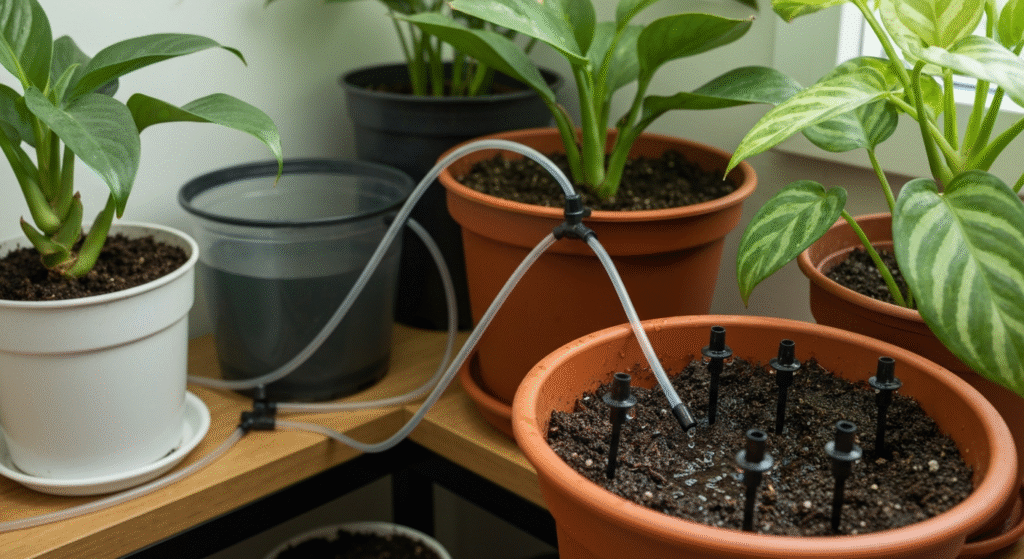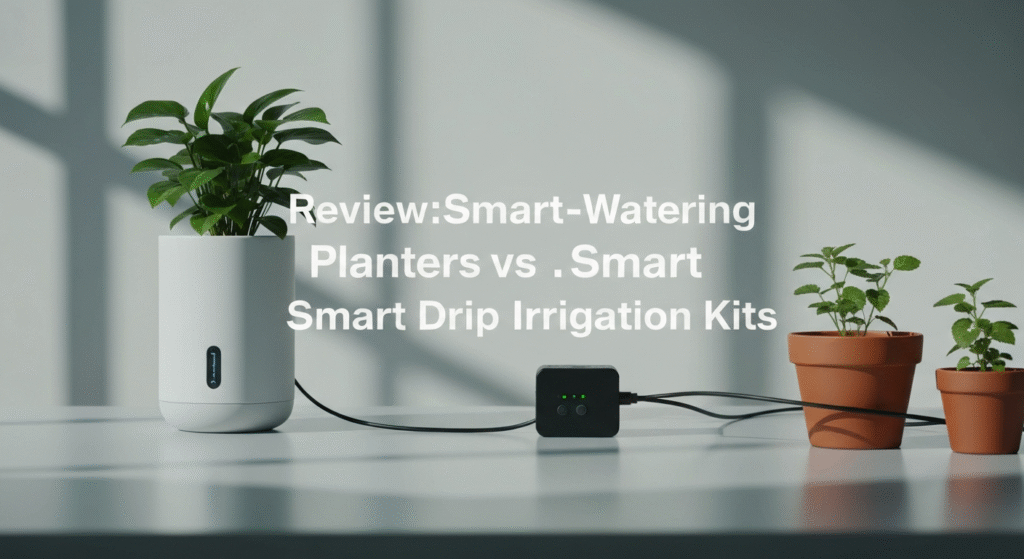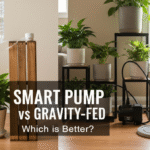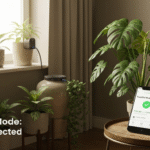Going on vacation used to fill me with a special kind of dread. Not about flying or packing, but about my plants. I’m guessing you know the feeling. You spend months nurturing a beautiful indoor garden, only to return from a week away to find a crispy, brown graveyard. Or, you ask a well-meaning neighbor to help, and they lovingly drown every plant you own.
For indoor gardeners, a consistent watering schedule is the single biggest challenge. We’re busy. We travel. And honestly, some plants are just plain fussy.
This is where smart home automation for our green friends comes in. The two biggest players in this game are smart self-watering planters and smart drip irrigation kits. They both promise to solve our watering woes, but they do it in completely different ways. And believe me, choosing the wrong one for your setup can lead to a lot of frustration (and wasted money).
Hello, I’m Priya. My own journey into smart indoor gardening started about five years ago, born from a mix of love for plants and frustration with my ‘black thumb.’ I was tired of the constant guessing game of over- or under-watering. This led me down a deep rabbit hole of testing countless sensors, pumps, and pots in my own small apartment garden. I’ve made all the mistakes (like flooding a bookshelf once) so you don’t have to, and I’m here to share what I’ve genuinely learned works.
This isn’t just a list of features. This is a hands-on review to help you decide which system is truly best for your home and your plants.
What Are We Even Talking About? A Quick Breakdown
Before we get into the big fight, let’s make sure we’re clear on what these two contenders are. They might sound similar, but they are worlds apart in how they operate.
Smart Self-Watering Planters: The “Set It and Forget It” Pot
At its core, a self-watering planter is a simple, clever design. It’s a pot with two main parts:
- A Growing Area: Where your plant and its soil live.
- A Water Reservoir: A tank, usually at the bottom, that you fill with water.
A wicking system (often a cotton rope or a porous, soil-like material) connects the reservoir to the soil. Through capillary action, the soil draws up just enough water to stay perfectly moist. The plant “drinks” only what it needs, when it needs it.
So, what makes it “smart”?
The “smart” part usually isn’t about the watering itself, which is passive. The smart feature is typically a sensor. This might be a simple floating indicator that tells you when the water is low, or it could be a Wi-Fi or Bluetooth-enabled sensor that sends an alert to your phone. This alert is the key: it changes the task from “When do I water?” to “The pot told me it’s thirsty.”
Smart Drip Irrigation Kits: The “Custom Network” for Your Plants

A smart drip irrigation kit is a completely different beast. It’s an active system, not a passive one. Think of it as a miniature, automated plumbing network for your plant collection.
A typical kit includes:
- A Pump: This is the heart of the system. It’s a small (often USB-powered) pump that you drop into your own large water reservoir (like a 5-gallon bucket or a stylish vase).
- Tubing: Thin, flexible tubes (the “veins”) that carry the water from the pump.
- Emitters (Drippers): Small stakes or nozzles (the “taps”) that you stick into the soil of each pot.
- A “Brain”: This is the smart controller, which is often part of the pump. It connects to your Wi-Fi and an app on your phone.
With this system, you are in complete control. You use the app to tell the pump, “At 8:00 AM every three days, turn on for 60 seconds and deliver water to all my plants.” You can customize the schedule and duration down to the second.
The Face-Off: How They Stack Up Head-to-Head
This is where the real decision-making happens. I’m going to break this down by the factors that really matter in an apartment or home setting, based on my own trial and (lots of) error.
Installation and Setup: How Fast Can You Get Started?
Smart Self-Watering Planters:
The setup is almost zero. You pot your plant in the planter just like you would a normal pot, fill the reservoir, and… you’re done. If it has a smart sensor, you’ll spend two minutes connecting it to your Wi-Fi or Bluetooth. It’s a 10-minute job, maximum.
- My Experience: This is what drew me in first. I bought a beautiful planter, potted my finicky fiddle-leaf fig, and my anxiety instantly dropped. It was simple, clean, and it just worked.
Smart Drip Irrigation Kits:
This is not a 10-minute job. This is a Saturday afternoon project. You have to:
- Find a place for your (potentially large) water reservoir.
- Set up the pump inside it.
- Measure and cut the thin tubing to reach every single plant.
- Connect all the tubes with little “T” splitters.
- Stake the emitters in each pot.
- Set up the app, schedule, and test the flow.
- My Experience: My first drip kit setup was… an event. It involved a lot of tiny scissors, some frustration getting the tube connectors to stop popping off, and a few small test-run dribbles on the floor. It is absolutely a DIY project that requires patience.
Winner: Smart Self-Watering Planters (by a landslide).
Precision and Control: Who Waters Smarter?
Smart Self-Watering Planters:
This system is passive. The plant controls the watering. It wicks up what it needs. This is fantastic for preventing the #1 killer of houseplants: overwatering. The soil is never saturated, just consistently moist. However, you have almost no control. You can’t tell it to water “less” or “more.” This makes it less ideal for plants that need a distinct “dry-out” period, like succulents or cacti.
Smart Drip Irrigation Kits:
This system gives you total control. You decide the “when” and the “how much.”
- Have a thirsty fern next to a dry-loving succulent? No problem. You can (on some advanced kits) set different zones or just add more emitters to the fern’s pot.
- Want to water for 30 seconds every day? Or 5 minutes once a week? You can do that.
- Want to sync watering with the weather? Some smart apps can even do that.
This precision is amazing, but it also has a learning curve. My first week, I set the timer for too long and nearly flooded my succulents. You have to experiment to find the perfect duration for your plants and soil type. If you’re new to this, it helps to learn more about proper houseplant watering techniques from a trusted source, so you can set your schedules with confidence.
Winner: Smart Drip Irrigation Kits (for precision and customization).
Scalability: What Happens When You Buy Another Plant?
This is, in my opinion, the most important category.
Smart Self-Watering Planters:
They do not scale. At all.
Got a new plant? You have to buy a whole new smart planter.
At $30, $50, or even $100+ per pot, this gets incredibly expensive, fast. If you have one “hero” plant you love, a smart planter is a great investment. If you have 15 plants, it’s a financial nightmare.
Smart Drip Irrigation Kits:
This is where they shine. Most starter kits are designed to handle 10-20 plants right out of the box. And if your collection grows? You don’t buy a new kit. You just buy a 50-cent “T” splitter and a few more feet of tubing. One single system, powered by one pump and one app, can manage your entire urban jungle.
Winner: Smart Drip Irrigation Kits (it’s not even a contest).
Maintenance: What’s the Real Long-Term Work?
Smart Self-Watering Planters:
The maintenance is distributed. If you have 10 smart planters, you have 10 reservoirs to refill. This can become its own chore, walking around the house with a watering can, refilling each one individually. You also need to deep clean the planters between plants to prevent salt and mineral buildup in the wicking system, which can stop it from working.
Smart Drip Irrigation Kits:
The maintenance is centralized. You only have one reservoir to refill, even if it waters 20 plants. This is a huge time-saver. However, the maintenance is more technical.
- Clogs: The tiny emitters can get clogged over time, especially if you have hard water or try to run liquid fertilizer through the system (more on that in the FAQs).
- Leaks: You have to check your connections and tubes every so often to make sure nothing has popped loose. The risk of a leak, while small, is real.
- My Experience: I’ve learned the hard way to run a diluted vinegar solution through my drip lines every few months. This clears out any mineral deposits and keeps the emitters flowing perfectly.
Winner: Tie. It’s a trade-off between easy but frequent (planters) and rare but technical (drip kits).
Cost: The Initial Price vs. The Long-Term Value
Smart Self-Watering Planters:
- Initial Cost: Low… if you only buy one ($30 – $100).
- Long-Term Cost: Extremely high. To automate 10 plants, you could easily spend $500+.
Smart Drip Irrigation Kits:
- Initial Cost: High ($70 – $150 for a good Wi-Fi kit).
- Long-Term Cost: Extremely low. The cost to add an 11th plant is less than a dollar. A single $100 kit can manage a $1,000 plant collection.
Winner: Smart Drip Irrigation Kits (for long-term value).
Aesthetics and Space: How Will It Look in Your Home?
Smart Self-Watering Planters:
They are clean and self-contained. Many are designed to be beautiful, minimalist objects that fit right into your home decor. There are no wires, no tubes, no buckets.
Smart Drip Irrigation Kits:
Let’s be honest: they can be ugly. The “out of the box” look is a web of black or clear plastic tubes running from a bucket. It’s very functional, but not very stylish. You can make it look good, but it takes work.
- My Experience: I’ve spent a lot of time on “tube management.” I hide my tubes by running them along the back of my bookshelves, using tiny command clips to secure them, and painting the main reservoir bucket to match my wall. It’s now very discreet, but it was an extra step.
Winner: Smart Self-Watering Planters.
Comparison at a Glance
I put together this simple table from my own notes. This isn’t a formal lab test, just my real-world findings from living with both systems.
| Feature | Smart Self-Watering Planters | Smart Drip Irrigation Kits |
| Best For | 1-5 plants; busy people; specific “hero” plants | 5+ plants; large collections; plant hobbyists |
| Setup Time | < 10 minutes per plant | 1-3 hours for the whole system |
| Control | Passive (Plant-controlled wicking) | Active (User-controlled schedule) |
| Scalability | Poor (Buy a new planter for each plant) | Excellent (Add cheap tubes/emitters) |
| Cost | High cost per plant | Low cost per plant (after initial kit) |
| Aesthetics | Often stylish and self-contained | Can be messy with tubes unless hidden |
| Maintenance | Refill individual reservoirs; clean pot | Refill one central reservoir; check for clogs |
My Experience: When I Chose Planters (and When I Switched to Drip)

As I mentioned, I’ve been on this journey for about five years. My evolution from “plant killer” to “smart gardener” perfectly mirrors the planter vs. drip debate.
The Early Days: Why Smart Planters Were My First Love
When I first started, I had three plants: a peace lily, a snake plant, and a fiddle-leaf fig I was terrified of. My fiddle-leaf was the reason I bought my first smart self-watering planter. It was expensive, but it was a single, beautiful pot that took all the guesswork away. It gave me confidence. My plant thrived. I was sold. I bought two more for my other plants. For a year, this system was perfect.
The Breaking Point: When My Plant Collection Exploded
Here’s the thing about plant-keeping: it’s an addiction. Three plants became five. Five became ten. Suddenly, I had a 12-foot-long bookshelf with 25 small-to-medium plants.
My “simple” solution was now a nightmare.
- Cost: I was not spending $50 on 22 more planters. That’s over $1,000.
- Labor: The chore I wanted to avoid (watering) had been replaced by a new chore: “The Great Reservoir Refill,” which involved me walking back and forth with a watering can, filling 25 separate little tanks. It was tedious and took just as long as regular watering.
My “Aha!” Moment with a Drip Kit
I finally ordered a Wi-Fi drip irrigation kit. As I said, the setup was a project. I laid out all my plants on the floor, mapped out the tubing, and spent an afternoon cutting and connecting. My “eureka!” moment came when I hid the 5-gallon water bucket inside a nice wicker basket, ran the main tube up the back of the bookshelf, and watched as, with one tap on my phone, all 25 plants got a perfect, 45-second drink.
Now, I refill one bucket every three weeks. When I go on vacation, I just check my app. And when I buy a new plant, I just smile, grab my tube cutters, and add it to the network.
The Final Verdict: Which One is Right for Your Indoor Garden?
There is no “better” product here. There is only the right product for your specific situation.
Choose Smart Self-Watering Planters If…
- You have only a few (1-5) plants that you want to dote on.
- You are not a “tinkerer” and want the absolute simplest setup possible.
- Aesthetics are your #1 priority. You want a clean, stylish pot with no visible tubes or wires.
- Your plants are spread far apart in different rooms.
- You have one or two large, expensive floor plants (like a big monstera or fig) that you just can’t risk losing.
Choose a Smart Drip Irrigation Kit If…
- You have a large collection (5+ plants) and it’s still growing.
- Your plants are grouped together on shelves, a plant stand, or a windowsill.
- You are budget-conscious in the long run and want the most scalable system.
- You enjoy a small DIY project and love the idea of having precise, app-based control.
- You travel frequently and need a large-capacity reservoir to care for your entire collection.
Frequently Asked Questions (FAQs)
Can I use fertilizer in these systems?
Yes, but be very careful. For drip kits, you can use a
well-dissolved liquid fertilizer in the main water reservoir. For wick-based planters, I do not recommend this. The fertilizer salts can build up in the wick and soil, eventually burning the plant’s roots or clogging the wick. It’s much safer to top-water with diluted fertilizer every few weeks.
What happens if my Wi-Fi goes down?
Most good smart drip kits are designed for this. They save the schedule directly on the device (the pump/controller). If your Wi-Fi cuts out, the system will continue to run its last saved schedule. You just won’t be able to make new changes from your app until it reconnects.
Are the pumps for drip irrigation kits noisy?
They make a low, humming or buzzing sound, but only when the pump is actively running. My schedule runs for 45 seconds once a day. I barely even notice it. It’s much quieter than a refrigerator or an aquarium filter.
Can I make my favorite “dumb” pot a smart self-watering planter?
Yes, in a way! You can buy self-watering “inserts” that are basically a reservoir and wick you place in the bottom of your existing decorative pot. You can also buy a standalone “smart soil moisture sensor.” This is just a stake you stick in the pot that connects to an app and alerts you when the soil is dry. It doesn’t water for you, but it tells you exactly when to do it.
Conclusion: Your Perfect Watering Partner
The best smart watering system is the one that fits your life and your collection. It’s the one that removes the anxiety of watering and lets you get back to just enjoying the green in your home.
Don’t be afraid to mix and match! My current setup is a hybrid: I have one big, beautiful smart planter for my large monstera in the living room, and a 20-plant drip irrigation system for the “jungle” on my bookshelf.
Start with what you need now. If you’re just starting, a self-watering planter is a fantastic way to build your confidence. And if your collection starts to take over, don’t worry. The world of drip irrigation will be waiting for you.


